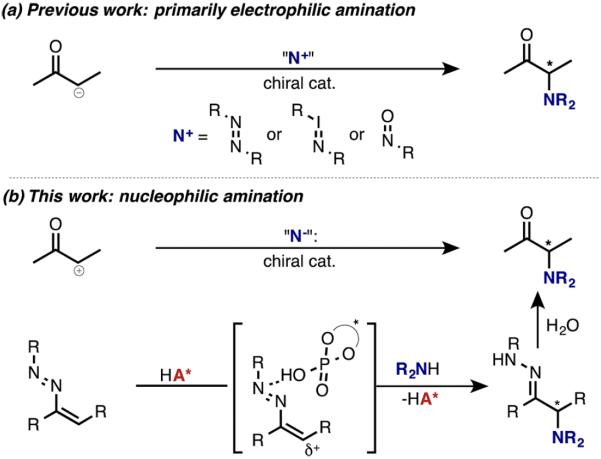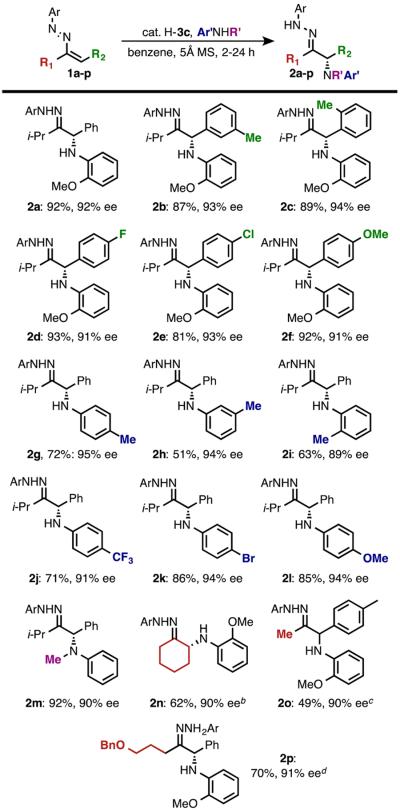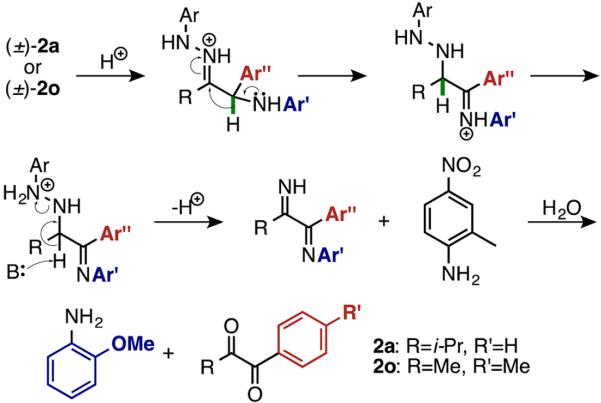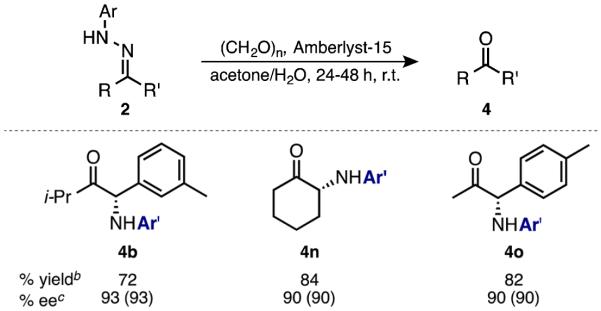Abstract
The enantioselective addition of anilines to azoalkenes was accomplished through the use of a chiral phosphoric acid catalyst. The resulting α-arylamino hydrazones were obtained in good yields and excellent enantioselectivities and provide access to enantioenriched α-arylamino ketones. A serendipitous kinetic resolution of racemic α-arylamino hydrazones is also described.
The formation and functionalization of amines has been an area of continuous interest in synthetic chemistry; numerous applications exist in the production of both pharmaceuticals and agrochemicals. The asymmetric α-amination of carbonyl moieties has emerged as an area of great interest over the past decade,1 with recent examples utilizing chiral Brønsted or Lewis acid,2 enamine,3 and Brønsted base4 catalysis as synthetic strategies to achieve high levels of enantioselectivity. Interestingly, the majority of these approaches utilize electrophilic sources of nitrogen, primarily azodicarboxylates and organonitroso compounds, with subsequent derivatization of the amine functionality (Scheme 1a).5 While alternative entries into enantioenriched α-amino carbonyl compounds have been described,6 highly enantioselective nucleophilic amination reactions remain illusive.7 A nucleophilic approach would allow for a broader scope of amine functionalization, potentially permitting incorporation of moieties, such as arylamines, that are challenging to access through electrophilic additions (Scheme 1b).
Scheme 1.
Enantioselective α-Amination Strategies
We sought to explore this regime through use of electrophilic azoalkenes which typically undergo 1,4 addition in the presence of various nucleophiles, with Lewis acids occasionally employed to promote reactivity.8 Following the recent successes of chiral phosphoric acid and phosphate catalysis reported by both our group and others,9 we envisioned a merger of these two concepts. Activation of an azoalkene by a chiral metal phosphate or phosphoric acid under the appropriate conditions would result in the formation of an activated intermediate. Subsequent nucleophilic attack and deprotonation would yield an enantioenriched α-amino hydrazine that could undergo hydrolysis to afford the corresponding ketone.
On the basis of a report of copper-catalyzed conjugate addition of amines to azoalkenes,8b we selected the reaction of 2-methoxyaniline and azoalkene 1a catalyzed by copper phosphate Cu(3a)2 (Cu-((R,R)-TRIP)2)10 as a model. Under these conditions, the desired product (2a) was formed with excellent selectivity, albeit in modest yield with other side products present (Table 1, entry 1). Other Lewis acidic phosphates11 gave similar reactivity profiles with some reduction in enantioselectivity (Table 1, entries 2–4). Interestingly, we found the desired product was more cleanly formed using the Brønsted acid catalyst H-3a ((R)-TRIP). Moreover, the enantioselectivity of the reaction was improved when the reaction was conducted in low polarity solvents, benzene being optimal (Table 1, entries 5–8). With a slow background reaction noted (Table 1, entry 13), we focused our attention on catalyst identity as a means to improve the enantioselectivity of the reaction. While use of H-3b resulted in slight improvements, the choice of the more sterically demanding H-3c catalyst resulted in excellent yield and ee of the desired product (Table 1, entries 9–10). Use of 3d and 3e12 as catalysts gave 2a in modest yield and selectivity (Table 1, entries 11–12).
Table 1.
| entry | cat. | solvent | conv. (%)c | yield (%)c | ee (%)d |
|---|---|---|---|---|---|
| 1 | Cu(3a)2 | benzene | 100 | 47 | 93 |
| 2 | Mg(3a)2 | benzene | 100 | 23 | 73 |
| 3 | Fe(3a)3 | benzene | 100 | 49 | 81 |
| 4 | Zn(3a)2 | benzene | 100 | 76 | 72 |
| 5 | H-3a | benzene | 100 | 52 | 84 |
| 6 | H-3a | acetonitrile | 100 | 98 | 4 |
| 7 | H-3a | THF | 59 | 46 | 58 |
| 8 | H-3a | DCM | 100 | 79 | 79 |
| 9 | H-3b | benzene | 100 | 57 | 86 |
| 10 | H-3c | benzene | 100 | 68 | 91 |
| 11 | 3d | benzene | 21 | 6 | 12 |
| 12 | 3e | benzene | 85 | 48 | 30e |
| 13 | - | benzene | 7 | 4 | - |
| 14f | H-3c | benzene | 100 | 63 | 82 |
Conditions: Ar′NH2 (0.025 mmol), 1a (3 equiv), 3 (0.10 equiv), solvent (0.25 mL), 5 Å MS (25 mg), r.t., 24 h.
Determined by 1H NMR with 1,3-dinitrobenzene as internal standard.
Determined by chiral phase HPLC. Absolute stereochemistry was assigned by analogy to 2g (see SI).
Opposite enantiomer.
5 Å MS omitted.
With the optimized conditions in hand, we explored the scope of the nucleophilic α-amination reaction (Table 2). A range of ortho-, meta-, para-substituted, electron-poor, and electron-rich azoalkenes gave excellent enantioselectivities utilizing 2-methoxyaniline as a nucleophile (Table 2, 2a–f). Similarly, substitution of the aniline nucleophile was well tolerated, with electron-rich and electron-poor anilines providing adducts with excellent ee, although yields were slightly diminished in some cases (Table 2, 2g–l). In all cases, we noted that extended reaction times resulted in product decomposition and lower yields. Encouragingly, addition of N-methylaniline proceeded smoothly under the reaction conditions, forming tertiary amine 2m in excellent enantioselectivity. Additionally, structurally unique products 2n and 2p could also be formed in moderate yields and excellent enantioselectivities utilizing catalyst H-3a.
Table 2.
Substrate Scopea
Conditions (see SI for details): 1, Ar′NHR', H-3c (0.10 equiv), benzene (1 mL), 5 Å MS (100 mg), r.t.; Ar: 2-Me-4-NO2–C6H3−; yields refer to isolated products; ee determined by chiral phase HPLC; absolute stereochemistry was assigned by analogy to 2g (see SI).
5 mol % H-3a; Ar: 4-NO2–C6H4−.
20 mol % H-3a.
10 mol % H-3a; values are for (Z) isomer; (E) isomer could not be separated and formed in 18% yield and 42% ee.
In contrast, subjecting methyl-substituted azoalkene 1o to similar reaction conditions produced 2o in modest yield (49%) and excellent ee (90%). Further analysis of this reaction showed that starting material was completely consumed after only 30 min; at this time 2o was produced in 67% yield but only 16% ee, compared to 90% ee after 14 h. Moreover, further increasing the reaction time to 28 h improved the enantioselectivity to 94%, albeit with a diminished yield of 32%.
This inverse relationship between yield and enantioselectivity is characteristic of a kinetic resolution. We hypothesized that the hydrazone, once formed, might undergo subsequent decomposition by the catalyst, with one enantiomer highly preferred, leading to enantioenrichment of any remaining hydrazone. To test our hypothesis, racemic 2o was prepared and subjected to the reaction conditions, with the starting material recovered in 92% ee and 36% yield (Scheme 2). Interestingly, if the reaction was stopped after 0.5 h, 30% ee was obtained. When compared with 14% ee obtained from the parent reaction after 0.5 h, this result is consistent with our hypothesis: significant enantioenrichment only takes place after the product is formed. Interestingly, subjecting racemic 2a to analogous reaction conditions resulted in similar decomposition, although with a negligible (1%) amount of enantiomeric excess. This result suggests that the mechanism for formation of enantioenriched 2o differs from that for generation of nonmethyl substituted azoalkenes.13
Scheme 2.
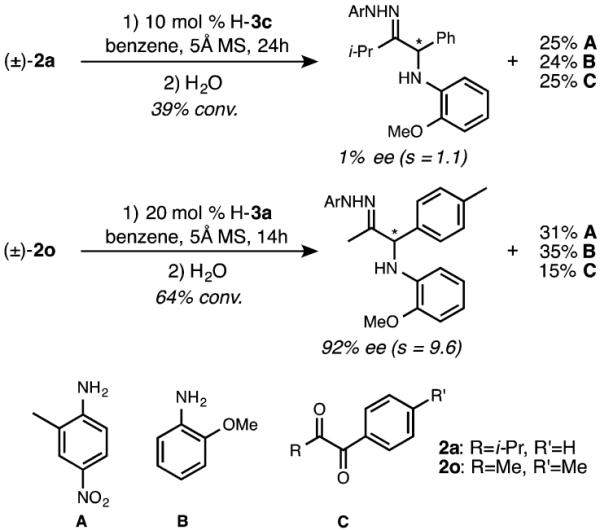
Kinetic Resolution of (±)-2o
Analysis of the product mixture derived from the reaction of (±)-2o showed that 2-methyl-4-nitro aniline, 1-(4-tolyl)-1,2-propanedione, and 2-methoxyaniline were formed in modest yields.14 In the case of racemic 2a, the analogous isopropyl-substituted ketone is similarly observed. On the basis of the formation of these products, a tentative reaction mechanism is posited in Scheme 3. Protonation of the imine nitrogen of 2a or 2o followed by an aniline-assisted [1,2]-hydride shift yields an intermediate hydrazine, which upon proton transfer and elimination yields a bisimine and 2-methyl-4-nitroaniline. Subsequent hydrolysis yields the remaining products.15,16
Scheme 3.
Potential Kinetic Resolution Mechanism
To demonstrate the utility of this method, the hydrazone products 3 were hydrolyzed in the presence of sacrificial formaldehyde to furnish ketones 4 in good yields while preserving the enantiomeric excess (Table 3).
Table 3.
Hydrazone Hydrolysisa
Conditions: 2 (0.06–0.08 mmol), paraformaldehyde (5–8 equiv), Amberlyst 15 (7–10 mg), acetone/H2O (10:1 or 1:1), r.t., 24–48 h (see SI for details) Ar′: 2-MeO-C6H4−
Isolated yield.
Determined by chiral phase HPLC; parentheses indicate ee of parent hydrazine; absolute stereochemistry was assigned by analogy to 2 (see SI).
In summary, a novel strategy for the enantioselective synthesis of α-aminoketones has been developed. Interaction of a chiral phosphoric acid and an azoalkene promotes addition of anilines, yielding highly enantioenriched α-amino hydrazones that undergo clean hydrolysis to afford the corresponding ketones. This reaction relies on the nucleophilicity of amines and therefore compliments previous entries to this class of compounds employing electrophilic nitrogen sources. Additionally, the discovery of a chiral phosphoric acid-catalyzed kinetic resolution is detailed,17 showing potential for future exploration and expansion. Extension of this methodology to other nucleophiles is currently underway.
Supplementary Material
ACKNOWLEDGMENTS
We gratefully acknowledge the NIGMS (R01 GM104534) for financial support. J.G. thanks Generalitat de Catalunya for a graduate research fellowship. We gratefully acknowledge College of Chemistry CheXray (NIH Shared Instrumentation Grant S10-RR027172) and Antonio DiPasquale for X-ray crystallographic data. We thank Maolu Li and Tao Wu for initial substrate synthesis and Mark Levin, Andrew Neel, and Chung-Yeh Wu for helpful discussions.
Footnotes
Supporting Information Experimental details, characterization data for new compounds, and crystallographic data (CIF). The Supporting Information is available free of charge on the ACS Publications website at DOI: 10.1021/jacs.5b04518.
The authors declare no competing financial interest.
REFERENCES
- (1).(a) Zhou F, Liao F-M, Yu J-S, Zhou J. Synthesis. 2014;46:2983. [Google Scholar]; (b) Vilaivan T, Bhanthumnavin W. Molecules. 2010;15:917. doi: 10.3390/molecules15020917. [DOI] [PMC free article] [PubMed] [Google Scholar]; (c) Marigo M, Jørgensen KA. Chem. Commun. 2006:2001. doi: 10.1039/b517090g. [DOI] [PubMed] [Google Scholar]; (d) Janey JM. Angew. Chem., Int. Ed. 2005;44:4292. doi: 10.1002/anie.200462314. [DOI] [PubMed] [Google Scholar]
- (2).Brønsted acid catalyzed: Wang S-G, Yin Q, Zhuo C-X, You S-L. Angew. Chem., Int. Ed. 2015;54:647. doi: 10.1002/anie.201409756. Nan J, Liu J, Zheng H, Zuo Z, Hou L, Hu H, Wang Y, Luan X. Angew. Chem., Int. Ed. 2015;54:2356–2360. doi: 10.1002/anie.201409565. Yang X, Toste FD. J. Am. Chem. Soc. 2015;137:3205–3208. doi: 10.1021/jacs.5b00229. H-bond donor catalyzed: Konishi H, Lam TY, Malerich JP, Rawal VH. Org. Lett. 2010;12:2028. doi: 10.1021/ol1005104. Agcatalyzed: Yanagisawa A, Miyake R, Yoshida K. Org. Biomol. Chem. 2014;12:1935. doi: 10.1039/c3ob42111b. Mg-catalyzed: Maji B, Baidyaab M, Yamamoto H. Chem. Sci. 2014;5:3941. Cu-catalyzed: Lalli C, Dumoulin A, Lebée C, Drouet F, Guérineau V, Touboul D, Gandon V, Zhu J, Masson G. Chem.—Eur. J. 2015;21:1704–1712. doi: 10.1002/chem.201405286. Sc-catalyzed: Li W, Liu X, Hao X, Hu X, Chu Y, Cao W, Qin S, Hu C, Lin L, Feng X. J. Am. Chem. Soc. 2011;133:15268. doi: 10.1021/ja2056159.
- (3).(a) Maji B, Yamamoto H. Angew. Chem., Int. Ed. 2014;53:8714. doi: 10.1002/anie.201311069. [DOI] [PubMed] [Google Scholar]; (b) Kano T, Shirozu F, Maruoka K. Org. Lett. 2014;16:1530. doi: 10.1021/ol5000742. [DOI] [PubMed] [Google Scholar]; (c) Xu C, Zhang L, Luo S. Angew. Chem., Int. Ed. 2014;53:4149. doi: 10.1002/anie.201400776. [DOI] [PubMed] [Google Scholar]; (d) Cecere G, König CM, Alleva JL, MacMillan DWC. J. Am. Chem. Soc. 2013;135:11521. doi: 10.1021/ja406181e. [DOI] [PMC free article] [PubMed] [Google Scholar]
- (4).(a) Takeda T, Terada M. J. Am. Chem. Soc. 2013;135:15306. doi: 10.1021/ja408296h. [DOI] [PubMed] [Google Scholar]; (b) Terada M, Nakano M, Ube H. J. Am. Chem. Soc. 2006;128:16044. doi: 10.1021/ja066808m. [DOI] [PubMed] [Google Scholar]
- (5).Electrophilic amine sources in nonenantioselective reactions: McDonald SL, Wang Q. Chem. Commun. 2014;50:2535. doi: 10.1039/c3cc49296f. Matsuda N, Hirano K, Satoh T, Miura M. Angew. Chem., Int. Ed. 2012;51:11827. doi: 10.1002/anie.201206755. Miura T, Morimoto M, Murakami M. Org. Lett. 2012;14:5214–5217. doi: 10.1021/ol302331k.
- (6).Aza-Benzoin: DiRocco DA, Rovis T. Angew. Chem., Int. Ed. 2012;51:5904. doi: 10.1002/anie.201202442. Rh-nitrene: Anada M, Tanaka M, Washido T, Yamawaki M, Abe T, Hashimoto S. Org. Lett. 2007;9:4559. doi: 10.1021/ol702019b. Rhcarbene N-H insertion: Xu B, Zhu S-F, Zuo X-D, Zhang Z-C, Zhou Q-L. Angew. Chem., Int. Ed. 2014;53:3913. doi: 10.1002/anie.201400236. Hypervalent iodine: Mizar P, Wirth T. Angew. Chem., Int. Ed. 2014;53:5993. doi: 10.1002/anie.201400405. α-Ketol rearrangements: Aitken DJ, Caboni P, Eijsberg H, Frongia A, Guillot R, Ollivier J, Piras PP, Secci F. Adv. Synth. Catal. 2014;356:941. Frongia A, Secci F, Capitta F, Piras PP, Sanna ML. Chem. Commun. 2013;49:8812. doi: 10.1039/c3cc45278f. α-Iminol Rearrangement: Zhang X, Staples RJ, Rheingold AL, Wulff WD. J. Am. Chem. Soc. 2014;136:13971. doi: 10.1021/ja5065685.
- (7).(a) Guha S, Rajeshkumar V, Kotha SS, Sekar G. Org. Lett. 2015;17:406. doi: 10.1021/ol503683q. [DOI] [PubMed] [Google Scholar]; (b) Jiang Q, Xu B, Zhao A, Jia J, Liu T, Guo C. J. Org. Chem. 2014;79:8750. doi: 10.1021/jo5015855. [DOI] [PubMed] [Google Scholar]; (c) Vander Wal MN, Dilger AK, MacMillan DWC. Chem. Sci. 2013;4:3075. [Google Scholar]; (d) Evans RW, Zbieg JR, Zhu S, Li W, MacMillan DWC. J. Am. Chem. Soc. 2013;135:16074. doi: 10.1021/ja4096472. [DOI] [PMC free article] [PubMed] [Google Scholar]; (e) Scarpino Schietroma DM, Monaco MR, Bucalossi V, Walter PE, Gentili P, Bella M. Org. Biomol. Chem. 2012;10:4692. doi: 10.1039/c2ob25595b. [DOI] [PubMed] [Google Scholar]
- (8).Cu-catalyzed: Attanasi OA, Favi G, Filippone P, Mantellini F, Moscatelli G, Perrulli FR. Org. Lett. 2010;12:468. doi: 10.1021/ol902642z. Attanasi O, Filippone P. Synthesis. 1984:422. Ti-catalyzed: Bozzini S, Felluga F, Nardin G, Pizzioli A, Pitacco G, Valentin E. J. Chem. Soc., Perkin Trans. 1996;1:1961. Thermal: Bozzini S, Gratton S, Risaliti A. Tetrahedron. 1984;40:5263. For an excellent discussion of the electrophilicity of 1,2-diaza-1,3-dienes see: Kanzian T, Nicolini S, De Crescentini L, Attanasi OA, Ofial AR, Mayr H. Chem.—Eur. J. 2010;16:12008. doi: 10.1002/chem.201000828.
- (9).(a) Parmar D, Sugiono E, Raja S, Rueping M. Chem. Rev. 2014;114:9047. doi: 10.1021/cr5001496. [DOI] [PubMed] [Google Scholar]; (b) Mahlau M, List B. Angew. Chem., Int. Ed. 2013;52:518. doi: 10.1002/anie.201205343. [DOI] [PubMed] [Google Scholar]; (c) Phipps RJ, Hamilton GL, Toste FD. Nat. Chem. 2012;4:603. doi: 10.1038/nchem.1405. [DOI] [PubMed] [Google Scholar]
- (10).Rauniyar V, Wang ZJ, Burks HE, Toste FD. J. Am. Chem. Soc. 2011;133:8486. doi: 10.1021/ja202959n. [DOI] [PubMed] [Google Scholar]
- (11).Yang L, Zhu Q, Guo S, Qian B, Xia C, Huang H. Chem.—Eur. J. 2010;16:1638. doi: 10.1002/chem.200902705. Lv J, Li X, Zhing L, Luo S, Cheng J-P. Org, Lett. 2010;12:1096. doi: 10.1021/ol1000928. Ingle GK, Liang Y, Mormino MG, Li G, Fronczek FR, Antilla JC. Org. Lett. 2011;13:2054. doi: 10.1021/ol200456y. For a review of metal organophosphates in asymmetric catalysis see: Parra A, Reboredo, Castro AMM, Alemán J. Org. Biomol. Chem. 2012;10:5001. doi: 10.1039/c2ob25479d.
- (12).(a) Nelson HM, Patel JS, Shunatona HP, Toste FD. Chem. Sci. 2015;6:170. doi: 10.1039/c4sc02494j. [DOI] [PMC free article] [PubMed] [Google Scholar]; (b) Neel AJ, Hehn JP, Tripet PF, Toste FD. J. Am. Chem. Soc. 2013;135:14044. doi: 10.1021/ja407410b. [DOI] [PMC free article] [PubMed] [Google Scholar]
- (13).Subjecting racemic 2n to an analogous experiment gave enantioenriched 2n with 21% conversion and 11% ee (s = 2.7). In contrast, enantioselectivity for the larger iso-propyl substituted product (2h) did not vary with time (4 h, 94% ee; 8 h, 93% ee; 16 h 93% ee), suggesting that this more sterically demanding product was not subject to the kinetic resolution.
- (14).The remaining mass balance of the reaction mixture consisted of a mixture of inseparable and unidentifiable products.
- (15).Acid-catalyzed enantioselective reactions incorporating [1,5]-hydride shifts have been developed utilizing aniline moieties: Mori K, Ehara K, Kurihara K, Akiyama T. J. Am. Chem. Soc. 2011;133:6166. doi: 10.1021/ja2014955. He Y-P, Du Y-L, Luo S-W, Gong L-Z. Tetrahedron Lett. 2011;52:7064. Kang YK, Kim SM, Kim DY. J. Am. Chem. Soc. 2010;132:11847. doi: 10.1021/ja103786c. For examples of phosphoric acid catalyzed pinacol and semipinacol rearrangements see: Zhang Q-W, Fan C-A, Zhang H-J, Tu Y-Q, Zhao Y-M, Gu P, Chen ZM. Angew. Chem., Int. Ed. 2009;48:8572. doi: 10.1002/anie.200904565. Liang T, Zhang Z, Antilla JC. Angew. Chem., Int. Ed. 2010;49:9734. doi: 10.1002/anie.201004778.
-
(16).Further support for this mechanism is demonstrated with an analogous oxime substrate, albeit with diminished selectivity:

- (17).For additional examples of chiral phosphoric acid-catalyzed reactions in which the products undergo further resolution see: Enders D, Narine AA, Tougoat F, Bisschops T. Angew. Chem., Int. Ed. 2008;47:5661. doi: 10.1002/anie.200801354. Akiyama T, Katoh T, Mori K. Angew. Chem., Int. Ed. 2009;48:4226. doi: 10.1002/anie.200901127. Mori K, Ichikawa Y, Kobayashi M, Shibata Y, Yamanaka M, Akiyama T. J. Am. Chem. Soc. 2013;135:3964. doi: 10.1021/ja311902f. Sun Z, Winschel GA, Zimmerman PM, Nagorny P. Angew. Chem., Int. Ed. 2014;53:11194. doi: 10.1002/anie.201405128.
Associated Data
This section collects any data citations, data availability statements, or supplementary materials included in this article.



